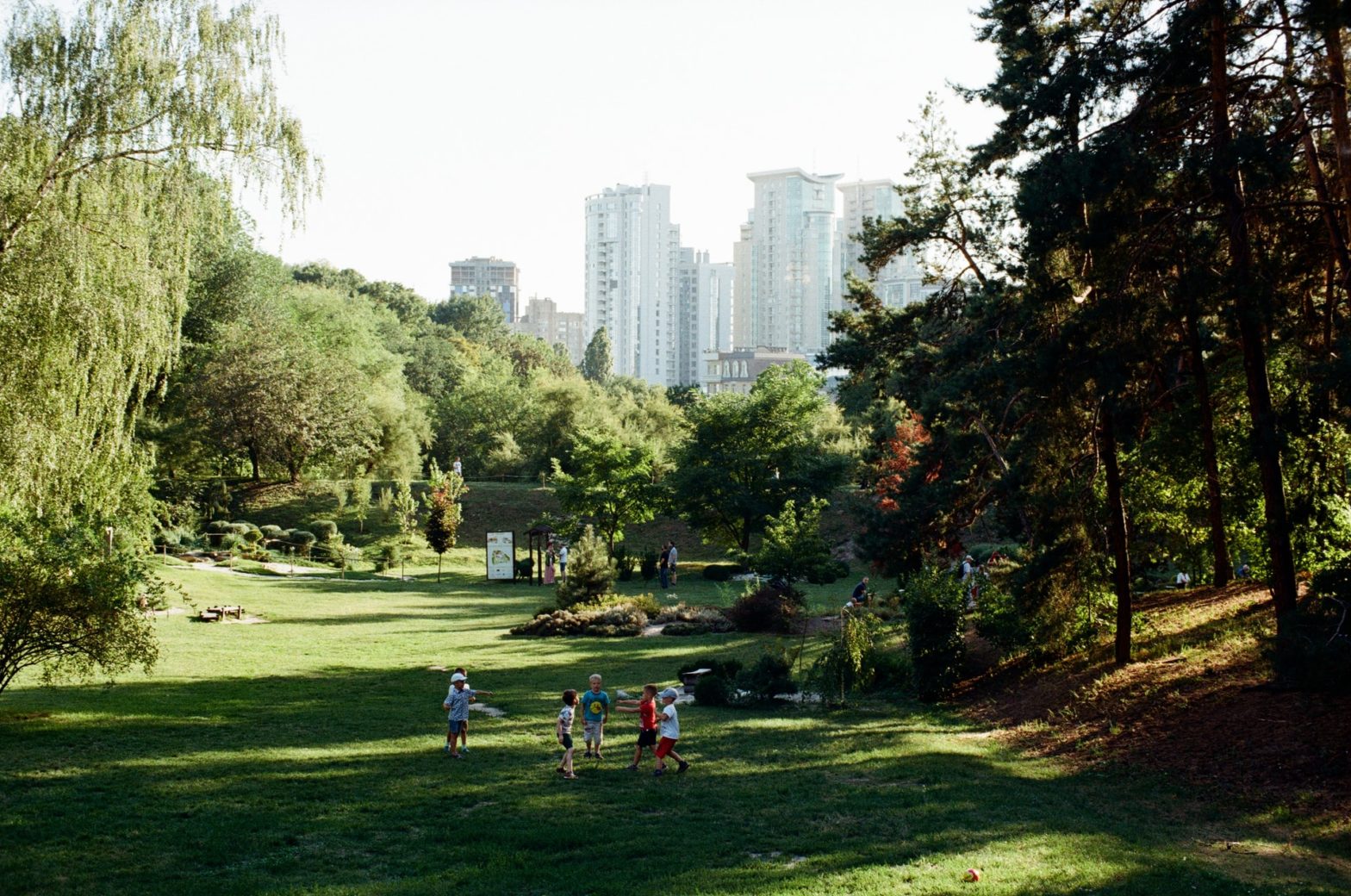
Photo: Rad Pozniakov on Unsplash
Forest-based solutions for enhancing quality of life in cities
30 September 2021
By: Asya Al Marhubi, Communications Officer, Cities4Forests
In fewer than 100 years, the world and its population will have transformed from predominantly rural to being predominantly urbanised, a transformation that has led to significant innovation and progress. Back in 1960, the urban population was only 30 percent but by 2050 it is expected to reach 70 percent, a complete reversal of the urban/rural dynamic.
Today, cities are the engines of growth around the world and according to the World Bank account for more than 80 percent of global GDP. Broadly speaking, urbanisation has not been managed sustainably and has resulted in negative impacts on public health, social equality, and is threatening the future liveability of cities. To enhance the liveability of their cities, city leaders must balance urban expansion and economic progress with social and environmental protection. Nature-based solutions – such as trees, forests and green areas – are increasingly being recognised as key for balancing social, economic and environmental development by delivering ecosystem services that are critical to sustainable urban development.
Most people don’t associate cities with trees, but urban areas are dependent on healthy forests across multiple scales. For example, trees within cities (inner forests) regulate temperatures, improve air quality and provide green areas that allow for recreation and social cohesion. Forests located on the outskirts of a city (nearby forests) provide drinking water and can help protect against natural disasters such as flooding or landslides. And even forests on the other side of the world (faraway tropical forests) are vital by helping to mitigate climate change, generate rainfall and provide commodities that are consumed by city residents.
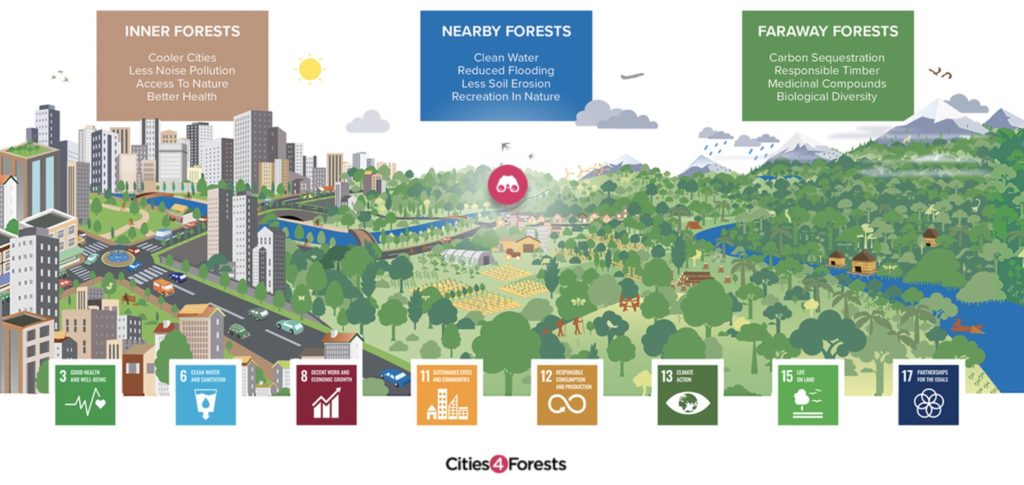
Thankfully, many cities across the world are beginning to recognise that the liveability of their city is connected with the health of forests by joining Cities4Forests, a city-led movement to protect and expand forests. Since its launch in 2018, more than 70 cities have declared action to protect, manage and restore forests across multiple scales. Cities4Forests helps cities by providing technical assistance, capacity building, and facilitating financial investment.
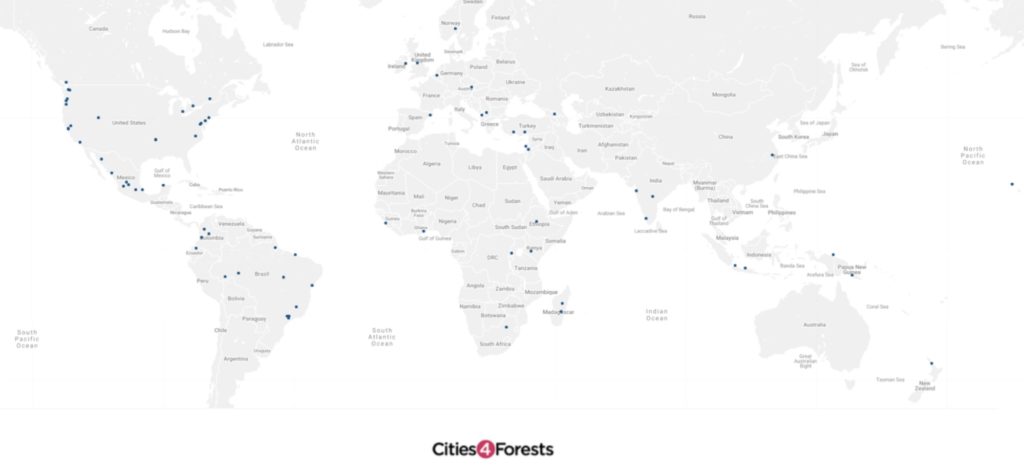
Cities and forests may seem like unlikely allies but their futures are becoming increasingly interlinked. Here’s a look at how cities across the world are managing forests across multiple scales to improve the quality of life for their residents:
How inner forests contribute to wellbeing
Trees within cities, from those that grow in parks to ones that line the streets, help with everything from regulating temperatures, improving air quality to boosting public health. Some of the benefits, or ecosystem services are visualised in the illustration below:
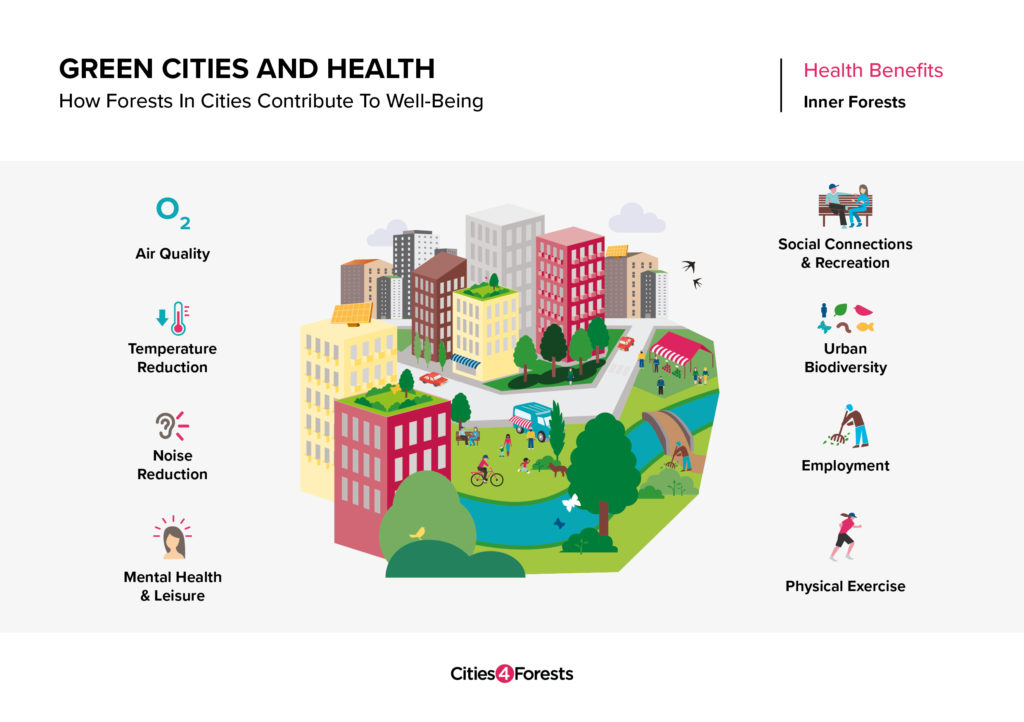
Mexico City is incorporating forests into its urban strategy to address multiple challenges. Nearly 60 percent of its territory is protected green space, which helps absorb rain to replenish the city’s overexploited aquifer, reduce carbon dioxide emissions and provide habitat to a diverse range of flora and fauna. Mexico City is working on increasing the quantity, quality and distribution of green areas. During the last six years, the city has developed new public parks and, through its Public Pocket Parks Program, has turned 28 underutilised areas into public spaces, including nearly 22,000m2 of green space within low-income neighbourhoods.
“The conservation of biodiversity is a transversal axis of the environmental policy of Mexico City. Through Cities4Forests, we hope to promote the creation of green infrastructure that will allow the conservation of biodiversity through the gradual reconstruction of green corridors. We are interested in the consolidation of the System of Natural Protected Areas and its integration into the Green Infrastructure Network of the Valley of Mexico Basin,” said Claudia Sheinbaum Pardo, Mayor of Mexico City
Addis Ababa, the capital of Ethiopia, carries out green development activities to create appealing and people-centred natural spaces. The goal is to increase the city’s green area per capita and mitigate climate change. The city administration is interested in using urban trees and forests to provide multiple health benefits for its residents, such as improving water resources, reducing air pollution and regulating the city’s temperature. The city is interested in exploring how green areas can increase rainfall for urban farming projects, and is also exploring how trees in the city’s nearby watershed areas can cleanse the air and help provide clean drinking water, reduce flooding and create job opportunities.
Brussels has a Public Welfare Climate Plan in place that advances three main inter-related themes for greening the city with more trees, vegetables and green paths. Since 2013 the city organises a participative public tree-planting exercise with residents who are invited to take part in converting a segment of the city into an urban forest. The city now permits residents to utilise balconies, rooftops and those square spaces around street trees to plant vegetables or flowers. Although the effect on reducing carbon emissions is minimal, the initiative is generating a positive impact on social cohesion and the well-being of citizens. The city of Brussels has also been developing a network of footpaths that link the different green spaces around the urban area with the peri-urban territories.
“By joining Cities4Forests, Brussels aims to underline the essential role of cities around the world in leading the efforts against global warming,” said Philippe Close, Mayor of Brussels.
How nearby forests contribute to wellbeing
Nearby forests underpin the existence of many of the world’s great cities by filtering water, reducing flooding, supplying timber, storing carbon, cleaning the air and providing access to nature for residents. From greenbelts hugging the outskirts of cities to mountain forests miles away, nearby forests play an underappreciated role in supporting city life.

Some of the most well-known examples of nearby forests include the Catskill and Delaware watersheds that provide water for the residents of New York City; the Cantareira Water Supply System, which supplies water for the 22 million residents of São Paulo; and the Aberdare Range “water tower” forests that supply much of Nairobi’s water and more than half of Kenya’s electricity through hydropower.
Although water security is the primary benefit of nearby forests for cities downstream, healthy nearby forests also deliver other essential ecosystem services, such as contributing to cleaner air by removing particulate matter and reducing the impact of natural disasters. When managed correctly, nearby forests can also be a source of sustainable local timber for building projects and could help replace carbon-intensive materials such as steel and concrete that are currently being used in construction.
Why cities need healthy tropical forests
Forests located far away from major cities are vital ecosystems for supporting all life on earth, including our dense urban areas. These forests include some of the world’s most iconic ecosystems, from central Africa and southeast Asia to the Amazon basin. They sequester vast amounts of carbon from the atmosphere, influence precipitation patterns, and provide essential commodities such as food, medicine and timber. These functions are essential for the planet and humanity.
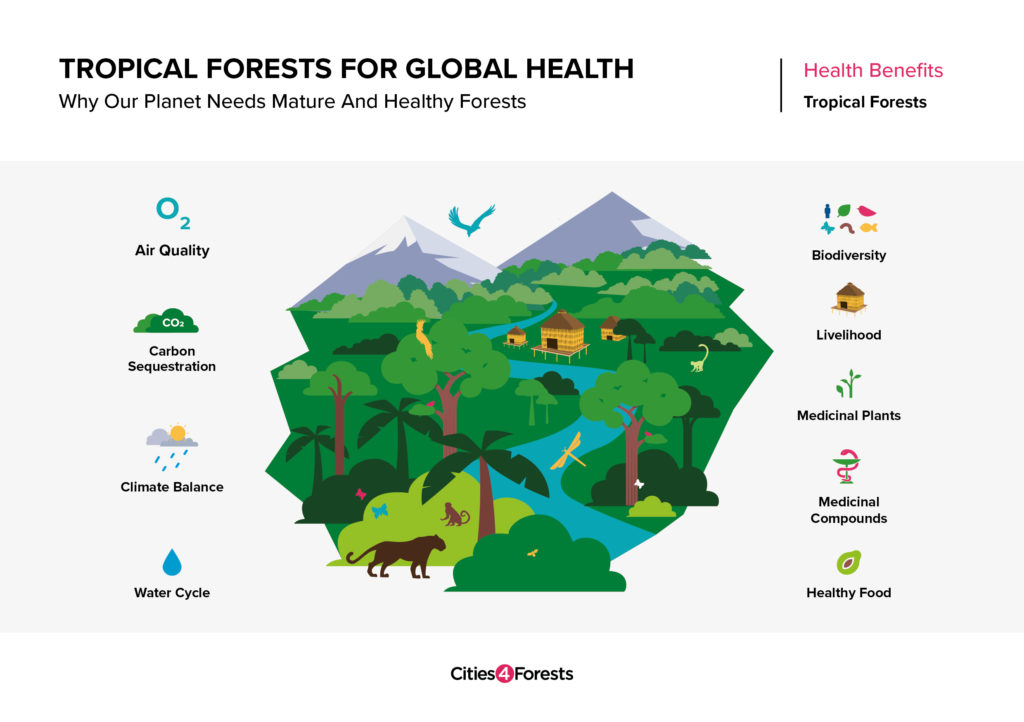
The natural ability of faraway tropical forests to sequester vast amounts of carbon means they must play a key role in mitigating climate change, which disproportionately affects cities. The threat of climate change is now becoming real and present, as evidenced by the increasing number of weather and climate disasters, ranging from wildfires to storms to droughts. According to the National Oceanic and Atmospheric Administration (NOAA), the US sustained 22 weather and climate disasters in 2020 where damages exceeded US$1 billion. Healthy forests can play a vital role in stabilising the climate through the absorption of carbon emissions, where it is estimated they could contribute to achieving more than one-third of the Paris Agreement targets.
Achieving this carbon mitigation potential calls for a paradigm shift in how we value forests and requires halting deforestation at scale and the promotion of forest restoration. According to the Food and Agriculture Organization (FAO), nearly 80 percent of global deforestation is driven by agriculture – beef, soy, and palm oil, where a disproportionate percentage of these products are consumed by cities. With UN projections estimating that nearly 70 percent of the world’s population will be living in urban areas by 2050, it is the responsibility of city leaders and residents to understand their interdependence on the health of faraway tropical forests and support conservation and restoration efforts.
Fortunately, hundreds of cities around the world have acted by supporting the protection and expansion of inner and nearby forests. At the local level, these actions are to be applauded and will help cities to cope with the effects of climate change, but at the global level, they are not sufficient for addressing a major contributor of climate change: deforestation and forest degradation. By becoming stewards of faraway tropical forests, cities across the world can play a vital role in the protection and expansion of natural carbon capture and storage technologies that will help to stabilise the climate and secure a better world for all of humanity.
Image: Rad Pozniakov on Unsplash










